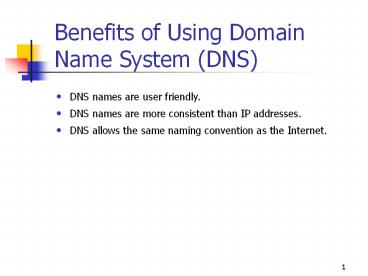Benefits of Using Domain Name System (DNS) PowerPoint PPT Presentation
Title: Benefits of Using Domain Name System (DNS)
1
Benefits of Using Domain Name System (DNS)
- DNS names are user friendly.
- DNS names are more consistent than IP addresses.
- DNS allows the same naming convention as the
Internet.
2
Domain Name Space
3
Examples of Second-Level Domains
- Ed.gov
- Microsoft.com
- Stanford.edu
- W3.org
4
Host Names
- Refer to specific computers on the Internet or an
intranet - The leftmost portion of a fully qualified domain
name (FQDN), such as Computer1.sales.microsoft.com
- Does not have to match the computer name
5
Domain Naming Guidelines
- Limit the number of domain levels.
- Use unique names.
- Use simple names.
- Avoid lengthy domain names.
6
Domain Naming Guidelines (continued)
- Use standard DNS characters and Unicode
characters - Microsoft Windows 2000 supports AZ, az, 09,
hyphen (-) - Supports Unicode character set
7
Zones
8
Name Servers
- Store the zone database file
- Store the database file(s) for one or multiple
zones - Have authority for the domain name space that the
zone encompasses - Are required in every zone
9
Primary Zone Database File
- A name server in each domain contains the master
database file. - Changes to a zone are performed on it.
- Multiple name servers act as a backup.
10
Benefits of Multiple Name Servers
- Provide zone transfers
- Provide redundancy
- Improve access speed
- Reduce the load
11
Name Resolution
- Resolving names to IP addresses
- DNS resolves www.microsoft.com to an IP address
12
Forward Lookup Query
13
Name Server Caching
14
Reverse Lookup Query
- Maps an IP address to a name.
- Used by troubleshooting tools such as the
nslookup utility. - Some applications implement security based on the
ability to connect to names.
15
The in-addr.arpa Domain
16
Introduction to DNS Clients
- DNS is a distributed database used in TCP/IP
networks. - TCP/IP must be installed to use DNS.
17
Internet Protocol (TCP/IP) Properties Dialog Box
PowerShow.com is a leading presentation sharing website. It has millions of presentations already uploaded and available with 1,000s more being uploaded by its users every day. Whatever your area of interest, here you’ll be able to find and view presentations you’ll love and possibly download. And, best of all, it is completely free and easy to use.
You might even have a presentation you’d like to share with others. If so, just upload it to PowerShow.com. We’ll convert it to an HTML5 slideshow that includes all the media types you’ve already added: audio, video, music, pictures, animations and transition effects. Then you can share it with your target audience as well as PowerShow.com’s millions of monthly visitors. And, again, it’s all free.
About the Developers
PowerShow.com is brought to you by CrystalGraphics, the award-winning developer and market-leading publisher of rich-media enhancement products for presentations. Our product offerings include millions of PowerPoint templates, diagrams, animated 3D characters and more.

